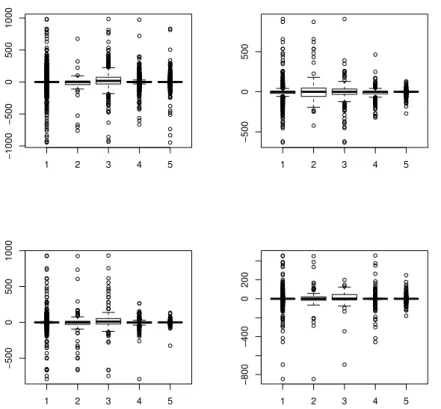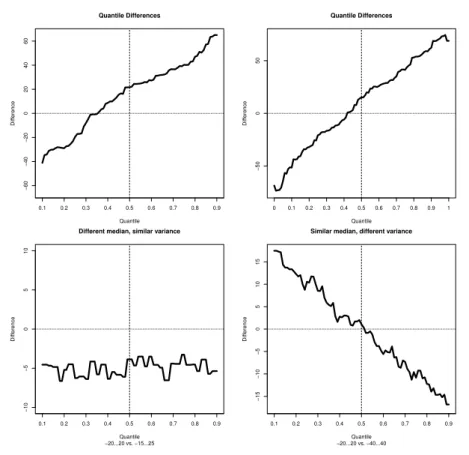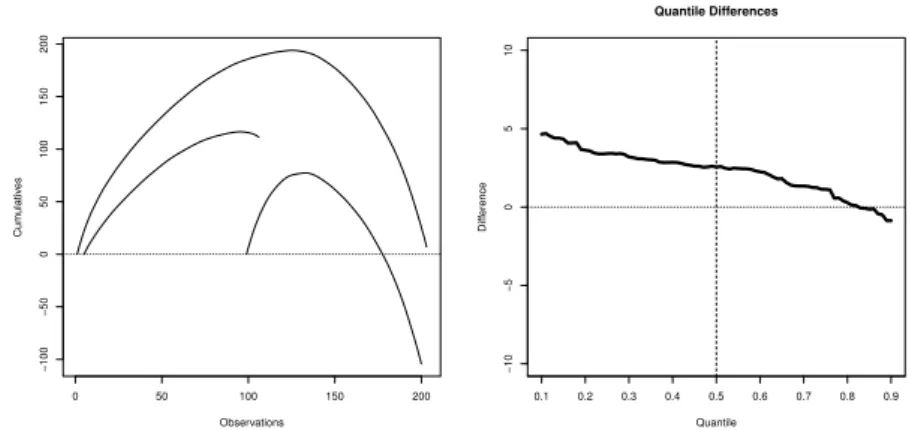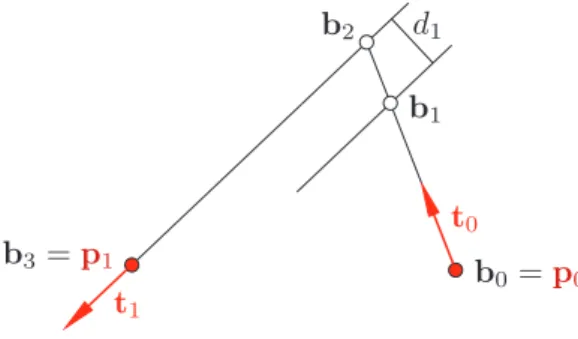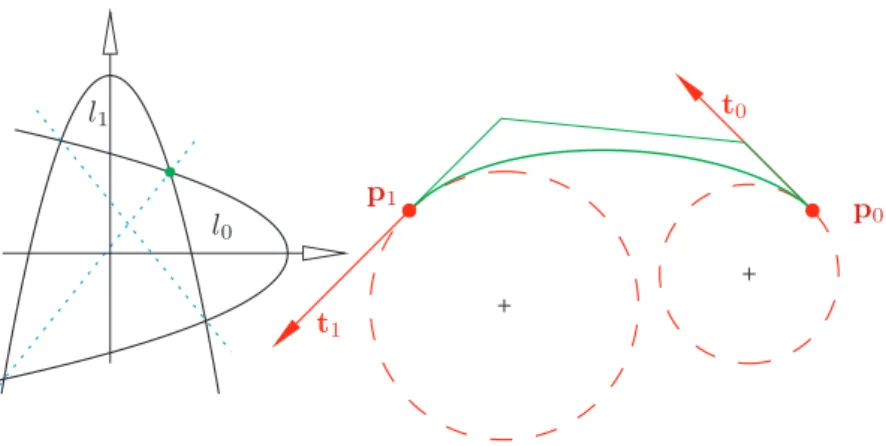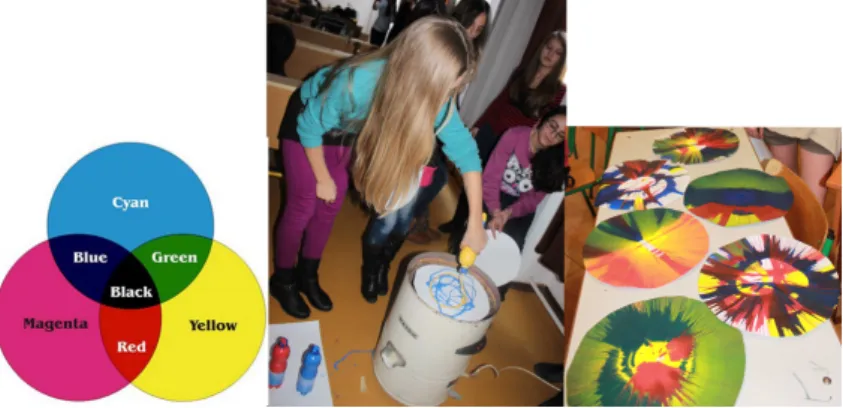Contents
V. Berezovski, S. Bácsó, J. Mikeš,Almost geodesic mappings of affinely connected spaces that preserve the Riemannian curvature . . . 3 P. Catarino, H. Campos, P. Vasco,On some identities for balancing and
cobalancing numbers . . . 11 S. S. Dragomir, Some inequalities for power series with nonnegative coef-
ficients via a reverse of Jensen inequality . . . 25 Cs. Faragó,Visualization of univariate data for comparison . . . 39 B. Faye, F. Luca,Pell and Pell-Lucas numbers with only one distinct digit . 55 I. Juhász,On geometric Hermite arcs . . . 61 G. Pataki, On the right-continuity of infimal convolutions . . . 69 D. G. Prakasha, K. Vikas, On weak symmetries of Kenmotsu Manifolds
with respect to quarter-symmetric metric connection . . . 79 J. L. Ramírez, V. F. Sirvent, A note on thek-Narayana sequence . . . . 91 J. Sándor,A note on log-convexity of power means . . . 107 H. Sangare, G. S. Lo, A general strong law of large numbers and appli-
cations to associated sequences and to extreme value theory . . . 111 Methodological papers
E. Perge,The experience of applying a method to develop the use of color theory . . . 135 R. Vajda,Exploring Hermite interpolation polynomials using recursion . . . 151 F. Várady,Introduction of differential calculus in the class 10 with graphical
calculator . . . 161
ANNALESMATHEMATICAEETINFORMATICAE45.(2015)
ANNALES
MATHEMATICAE ET INFORMATICAE
TOMUS 45. (2015)
COMMISSIO REDACTORIUM
Sándor Bácsó (Debrecen), Sonja Gorjanc (Zagreb), Tibor Gyimóthy (Szeged), Miklós Hoffmann (Eger), József Holovács (Eger), Tibor Juhász (Eger), László Kovács (Miskolc), László Kozma (Budapest), Kálmán Liptai (Eger), Florian Luca (Mexico), Giuseppe Mastroianni (Potenza), Ferenc Mátyás (Eger),
Ákos Pintér (Debrecen), Miklós Rontó (Miskolc), László Szalay (Sopron), János Sztrik (Debrecen), Gary Walsh (Ottawa)
HUNGARIA, EGER
ANNALES MATHEMATICAE ET INFORMATICAE International journal for mathematics and computer science
Referred by
Zentralblatt für Mathematik and
Mathematical Reviews
The journal of the Institute of Mathematics and Informatics of Eszterházy Károly College is open for scientific publications in mathematics and computer science, where the field of number theory, group theory, constructive and computer aided geometry as well as theoretical and practical aspects of programming languages receive particular emphasis. Methodological papers are also welcome. Papers sub- mitted to the journal should be written in English. Only new and unpublished material can be accepted.
Authors are kindly asked to write the final form of their manuscript in LATEX. If you have any problems or questions, please write an e-mail to the managing editor Miklós Hoffmann: hofi@ektf.hu
The volumes are available athttp://ami.ektf.hu
ANNALES
MATHEMATICAE ET INFORMATICAE
VOLUME 45. (2015)
EDITORIAL BOARD
Sándor Bácsó (Debrecen), Sonja Gorjanc (Zagreb), Tibor Gyimóthy (Szeged), Miklós Hoffmann (Eger), József Holovács (Eger), Tibor Juhász (Eger), László Kovács (Miskolc), László Kozma (Budapest), Kálmán Liptai (Eger), Florian Luca (Mexico), Giuseppe Mastroianni (Potenza), Ferenc Mátyás (Eger),
Ákos Pintér (Debrecen), Miklós Rontó (Miskolc), László Szalay (Sopron), János Sztrik (Debrecen), Gary Walsh (Ottawa)
INSTITUTE OF MATHEMATICS AND INFORMATICS ESZTERHÁZY KÁROLY COLLEGE
HUNGARY, EGER
HU ISSN 1787-6117 (Online)
A kiadásért felelős az Eszterházy Károly Főiskola rektora Megjelent az EKF Líceum Kiadó gondozásában
Kiadóvezető: Czeglédi László Műszaki szerkesztő: Tómács Tibor Megjelent: 2015. december Példányszám: 30
Készítette az
Eszterházy Károly Főiskola nyomdája Felelős vezető: Kérészy László
Almost geodesic mappings of affinely connected spaces that preserve the
Riemannian curvature ∗
Vladimir Berezovski
a, Sándor Bácsó
b, Josef Mikeš
caUman National University of Horticulture, Ukraine berez.volod@rambler.ru
bDebrecen University, Hungary bacsos@unideb.hu
cPalacky University Olomouc, Czech Republic josef.mikes@upol.cz
Submitted July 22, 2015 — Accepted September 29, 2015
Abstract
In the present paper the authors give some conditions preserved Rieman- nian curvature tensor with respect to almost geodesic mappings of affinely connected spaces. It is noteworthy that these conditions are valid for other types of mappings. For the almost geodesic mappings of first type, when the Riemannian curvature tensor is invariant, the authors deduce a differential equations system of Cauchy type.
In addition the authors investigate almost geodesic mappings of first type, where the Weyl tensor of projective curvature is invariant and Riemannian tensor is not invariant.
Keywords:almost geodesic mapping, Riemannian curvature tensor MSC:53B05
∗The paper was supported by the grant IGA Faculty of Science 2014016 Mathematical Struc- tures of the Palacky University
45(2015) pp. 3–10
http://ami.ektf.hu
3
1. Introduction
Several works [1, 2, 3, 4, 5, 6, 7, 8, 9, 10, 11, 12, 14, 15, 16, 17, 18, 19, 20, 21, 22, 23, 24] have been devoted to study almost geodesic mappings. These mappings are generalization of geodesic and quasigeodesic mappings, see [11, 12, 13, 17].
The basic concepts of almost geodesic curve and almost geodesic mapping of affinely connected spaces are introduced in paper [15] and included in the mono- graphs [17, p. 156], [12, p. 457] and surveys [18, 4, 8, 10].
Definition 1.1. A curvex(t)in an affinely connected spaceAnis called analmost geodesic curveif there exists a planeτ(t)in every tangent space of the curvex(t) such that:
(1) τ(t)are parallel translated alongx(t), and (2) the tangent vectorx(t)˙ of the curve lies inτ(t).
Definition 1.2. A diffeomorphismf:An→A¯nis calledalmost geodesic mapping, if underf any geodesic curve ofAn coincides with an almost geodesic curve ofA¯n. Theorem 1.3. Diffeomorphism f:An → A¯n is almost geodesic mapping if and only if the deformation tensor of the affine connections Pijh(x) ≡Γ¯hij(x)−Γhij(x) satisfies for any vectorλh the following conditions:
Ahαβγλαλβλγ =a Pαβh λαλβ+b λh where
Ahijk=Pij,kh +PijαPkαh , (1.1) Γhij (¯Γhij)are objects of affine connections of spaces An ( ¯An) respectively, a andb are some functions depend on xh and λh and x= (x1, x2, . . . , xn) is a common system of coordinates. The symbol “ ,” means covariant derivation with respect toAn.
Three types of almost geodesic mapping was discovered by Sinyukov [15, 16, 17, 18], he called them π1, π2 and π3. In [2] it was proved that another almost geodesic mapping, ifn >5 does not exist.
Almost geodesic mappingπ1 is characterized by the following conditions:
Ah(ijk)=δ(ihajk)+b(iPjk)h ,
where aij is a symmetric tensor,bi is a vector, and the symbol (ijk)means sym- metrization without division for the indicesi, j, k.
2. Mappings of affinelly connected spaces that pre- serve the Riemann curvature tensor
If we give a diffeomorphism f: An → A¯n, then the relation between Riemann curvature tensors Rhijk and R¯hijk of An and A¯n is the following [18, p. 78], [11, p. 86], [12, p. 184]:
R¯hijk=Rhijk+Pi[k,j]h +Pi[kαPj]αh , (2.1) where the symbol[kj]denotes the alternalization for the indiceskandj.
Using of (1.1) and (2.1) we have
Theorem 2.1. A mapping preserves the Riemann curvature tensor if and only if it satisfies the condition
Ahijk =Ahikj, (2.2)
that is, the tensor Ahijk is to be symmetric in the indicesj andk.
If the Riemann curvature tensor is preserved by the mapping, then, of course, Ricci tensorRij =Rαiαj and Weyl tensor of projective curvature
Wijkh =Rhikj− 1
n+ 1 δihR[jk]+ 1
n2−1 [(nRij+Rji)δkh−(nRik+Rki)δjh] (2.3) also are invariant under this mapping.
The condition of Theorem 1.3 is sufficient condition for preserving the Ricci tensor and Weyl tensor of projective curvature, but it is not necessary. Further on we give an example.
3. Special almost geodesic mappings of first type which preserve Riemannian tensor
Let be a mapping given between affinely connected spacesAn andA¯n, which sat- isfies the condition:
Pij,kh +Pik,jh =−PijαPαkh −PikαPαjh +δ(ihajk) (3.1) This mapping is a special case of almost geodesic mapping of first type.
Alternating equation (3.1) iniandj, we get
Pik,jh −Pjk,ih =−PikαPαjh +PjkαPαih. (3.2) At now in (3.2), we exchange the indicesiandk, we obtain
Pik,jh −Pji,kh =−PikαPαjh +PjiαPαkh . (3.3) If we subtract equation (3.3) from equation (3.1), we have
2Pij,kh =−2PijαPαkh +δh(iajk),
that is,
Pij,kh +PijαPαkh =δh(i˜ajk), (3.4) wherea˜ij = 12aij.
In this case the tensorAhijk=δh(i˜ajk)is symmetric in indices j andk. Using of Theorem 1.3 we have
Theorem 3.1. The almost geodesic mapping (determined by (3.1)) preserves the Riemann curvature tensorRhijk.
If Riemann curvature tensor vanishes in an affine space, then we have the fol- lowing
Theorem 3.2. If an affine space An admits an almost geodesic mapping (deter- mined by (3.1)) into A¯n, thenA¯n is also an affine space.
So affinely spaces are closed under almost geodesic mapping (determined by (3.1)).
From equation (3.1) we obtained the equation (3.4). Equation (3.4) is a system of Cauchy type for deformation tensor. We can find it’s integrability conditions.
We differentiate covariantly equation (3.4) by xm, further on, we change the indicesk andm, using of Ricci identities we have
δih˜aj[k,m]+δhj˜ai[k,m]+δh[k˜aij,lm]=PijαRhαkm+Pα(jh Ri)kmα + ˜aj[mPk]ih +˜ai[mPk]jh . (3.5) After transvecting of integrability conditions (3.5) by indiceshand mwe obtain
˜
ajk,i+ ˜aik,j−(n+ 1)˜aij,k=−PijαRαk+PαjβRαikβ+PαiβRαjkβ
+˜ajαPkiα−˜ajkPαiα + ˜aiαPjkα −˜aikPjαα. (3.6) Alternating equation (3.6) inkandj, we obtain
˜
aij,k= ˜aik,j+n+21 (−PijαRαk+PikαRαj−PαjβRαikβ+Pαkβ Rαijβ−
PαiβRαjkβ+PαiβRkjβα −˜ajαPkiα+ ˜akαPijα+ ˜aikPjαα −a˜ijPkαα). (3.7) In equation we exchange the indiceskandi, we get
˜
akj,i= ˜aik,j+n+21 (−PkjαRαi+PkiαRαj−PαjβRαkiβ+PαiβRαkjβ−
Pαkβ Rαjiβ+Pαkβ Rαijβ−˜ajαPikα+ ˜aiαPkjα + ˜akiPjαα −a˜kjPiαα). (3.8) Substituting equation (3.7) and (3.8) into (3.6), we have
˜
aik,j = (n−1)(n+2)1 (−n(PikαRαj+Pα(kβ Rαi)jβ))−Rα(kPi)jα −PαjβRα(ik)β−
Pα(iβ Rα|j|k)β+ (n+ 1)(˜aj(iPαk)α−˜aα(iPk)jα ) + 2(˜aikPjαα −˜ajαPikα)). (3.9) Equation (3.4) and (3.9) are a system of Cauchy type for the functionPijh(x) and
˜
aij(x), which satisfy the following
Pijh(x) =Pjih(x), a˜ij(x) = ˜aji(x). (3.10) So is proved the
Theorem 3.3. An affinely connected spaceAn admits an almost geodesic mapping (determined by (3.1)) into an affinely connected spaceA¯n if and only if inAn exist solution functionsPijh(x)and˜aij(x)for equation system of Cauchy type(3.4),(3.9) and (3.10).
4. Special almost geodesic mappings of first type which preserve Weyl tensor of projective curva- ture but does not preserve Riemann curvature tensor
Let be thef: ¯An→A¯n mapping given, which satisfies the following condition Pij,kh +PijαPαkh =δhkaij, (4.1) whereaij is a symmetric tensor.
It is well known, that this above mentioned mapping is an almost geodesic mapping of first type.
The tensor Ahijk on the basis of (4.1) is equal to δkhaij. If the tensor aij 6≡0, then the tensorAhijkis not symmetric in indicesjandk. So, in general the mapping (determined by (4.1)) does not preserve the Riemannian curvature tensor.
Using of (2.1) and (4.1) we get
R¯ijkh =Rhijk−ai[jδhk]. (4.2) It is easy to see, that after transvecting (4.2) in indiceshandk, we have
aij= 1
n−1 ( ¯Rij−Rij).
From the last formulae, symmetryaij, (2.3) and (4.2) we get W¯ij=Wij, W¯˜hijk= ˜Wijkh , and W¯ijkh =Wijkh where
Wij =Rij−Rji and W˜ijkh =Rhijk+ 1
n−1Ri[jδk]h. TheWij andW¯ij are tensors of type 02
in the spaceAnandA¯n respectively. The W˜ijkh and W¯˜ijkh are tensors of type 13
in the space An and A¯n respectively. The Wijkh andW¯ijkh are Weyl tensors of projective curvature ofAn andA¯nrespectively.
Finally we obtain
Theorem 4.1. TensorsWij,W˜hijk andWijkh are invariants under almost geodesic mapping (determined by (4.1)).
From Theorem 3.3 follows
Theorem 4.2. If a projective-euclidean or equiaffinely space An admits almost geodesic mapping (determined by (4.1)) into an affinely connected spaceA¯n, then A¯n is a projective-euclidean or equiaffinely space respectively.
The proof of Theorem 4.1 follows from facts, that the Weyl tensor vanishes in projective-euclidean space, and the tensor is equal to zero in equiaffinely space.
So, using of Theorem 4.1, we obtain, that the projective-euclidean and equiaffi- nely spaces are closed sets under almost geodesic mapping (determined by (4.1)).
For almost geodesic mapping of first type, which determined by (4.1), the tensor Ahijk is equal to δihaij . Ifaij 6≡0, then theAhijk tensor is not symmetric in indices j andk.
So, the mapping (determined by (4.1)) does not preserve the Riemann curvature tensor, but the Weyl tensor is invariant object.
Consider the equations (4.1) as a system of Cauchy-type for unknownPijh, find it’s integrability condition. At first, we differentiate covariantly equation (4.1) in xm, further on we alternate it in indiceskandm. After transvecting integrability condition of equation (4.1) in indiceshandm, we obtain
(n−1)aij,k =PijαRαk−Pα(iβ Rαj)βk−(n−1)Pijαaαk (4.3) So equation (4.1) and (4.3) in a spaceAngive a system of Cauchy type for unknown functionsPijh(x)andaij(x), which satisfies algebraic conditions
Pijh(x) =Pjih(x), aij(x) =aji(x) (4.4) Therefore
Theorem 4.3. An affinely connected space admits almost geodesic mapping of first type (determined by (4.1)) into an affinely connected spaceA¯n if and only if inAn
there exist solution Pijh(x) and aij(x) for system of Cauchy type equations (4.1), (4.3)and (4.4).
References
[1] Aminova, A. V., Group of amost projective motions of spaces with affine connection, Sov. Math., 23:4 (1979) 71–74. Transl. fromIzv. vuzov, Mat., 4 (1979) 71–75.
[2] Berezovski, V. E., Mikeš, J., On a classification of almost geodesic mappings of affine connection spaces,Acta Univ. Palacki. Olomuc., Math., 35 (1996) 21–24.
[3] Berezovski, V. E., Mikeš, J., Almost geodesic mappings of type π1 onto gen- eralized Ricci-symmetric manifolds, Uch. zap. Kazan. Univ. Ser. Fiz.-Math., 151:4 (2009) 9-14.
[4] Berezovski, V. E., Mikeš, J., Almost geodesic mappings of spaces with affine connection. J. Math. Sci. New York, 2015. Transl. from Itogi nauk, RAN VINITI, 126 (2013) 62–95.
[5] Berezovski, V. E., Mikeš, J., On canonical almost geodesic mappings of the first type of affinely connected spaces, Russ. Math., 58:2 (2014) 1–5. Transl. from Izv.
vuzov, Mat., 2 (2014) 3–8.
[6] Berezovski, V. E., Mikeš, J., Vanžurová, A., Canonical almost geodesic map- pings of typeπ1 onto pseudo-Riemannian manifolds,DGA Proc. Conf., World Sci., (2008) 65–76.
[7] Berezovski, V. E., Mikeš, J., Vanžurová, A., Almost geodesic mappings onto generalized Ricci-symmetric manifolds, Acta Math. Acad. Paed. Nyházi. (N.S.) 26:2 (2010) 221–230.
[8] Berezovski, V. E., Mikeš, J., Vanžurová, A., Fundamental PDE’s of the canon- ical almost geodesic mappings of typeπ˜1.Bull. Malays. Math. Sci. Soc., 37:3 (2014) 647–659.
[9] Formella, S., A note on geodesic and almost geodesic mappings of homogeneous Riemannian manifolds,Opusc. Math., 25:2 (2005) 181–187.
[10] Mikeš, J., Holomorphically projective mappings and their generalizations,J. Math.
Sci. (New York), 89:3 (1998) 1334–1353. Transl. fromItogi Nauki Tekh., Ser. Sovrem Mat. Prilozh., Temat. Obz., 30 (2002) 258–289.
[11] Mikeš, J., Hinterleitner, I., Vanžurová, A., Geodesic mappings and some generalizations,Palacky Univ. Press, Olomouc, (2009).
[12] Mikeš, J., at al., Differential geometry of special mappings,Palacky Univ. Press, Olomouc, (2015).
[13] Petrov, A. Z., Modeling of the paths of test particles in gravitation theory,Gravit.
and the Theory of Relativity, 4-5 (1968) 7–21.
[14] Petrović, M. Z., Stanković, M. S., Special almost geodesic mappings of the first type of non-symmetric affine connection spaces,Bull. Malays. Math. Sci. Soc., DOI 10.1007/s40840-015-0118-0 (2015).
[15] Sinyukov, N. S., Almost geodesic mappings of affinely connected and Riemannian spaces,Sov. Math., Dokl., 4 (1963) 1086–1088. Transl. fromDokl. Akad. Nauk SSSR, 151 (1963) 781–782.
[16] Sinyukov, N. S., Almost-geodesic mappings of affinely-connected spaces and e- structures,Math. Notes, 7 (1970) 272–278.
[17] Sinyukov, N. S., Geodesic mappings of Riemannian spaces,Nauka, Moscow, (1979).
[18] Sinyukov, N. S., Almost-geodesic mappings of affinely connected and Riemann spaces, J. Sov. Math., 25 (1984) 1235–1249. Transl. from Itogi Nauki Tekh., Ser.
Probl. Geom., 13 (1982) 3–26.
[19] Sobchuk, V. S., Almost geodesic mappings of Riemann spaces onto symmetric Riemann spaces,Math. Notes, 17 (1975) 450–454.
[20] Sobchuk, V. S., Interior almost geodesic mappings,Sov. Math., 33:5 (1989) 97–101.
Transl. fromIzv. vuzov, Mat., 324:5 (1989) 62–64.
[21] Sobchuk, V. S., Mikeš, J., Pokorná, O., On almost geodesic mappings π2
between semisymmetric Riemannian spaces, Novi Sad J. Math., 29:3 (1999) 309–
312.
[22] Stanković, M. S., On canonic almost geodesic mappings of the second type of affine spaces,Filomat,13(1999) 105–144.
[23] Vavříková, H., Mikeš, J., Pokorná, O., Starko, G., On fundamental equations of almost geodesic mappings of type π2(e), Russ. Math., 51:1 (2007) 8–12. Transl.
fromIzv. vuzov, Mat., 1 (2007) 10–15.
[24] Yablonskaya, N. V., Special groups of almost geodesic transformations of spaces with affine connection, Sov. Math., 30:1 (1986) 105–108. Transl. from Izv. vuzov, Mat., 284:1 (1986) 78–80.
On some identities for balancing and cobalancing numbers
Paula Catarino, Helena Campos, Paulo Vasco
∗Universidade de Trás-os-Montes e Alto Douro, UTAD,www.utad.pt Quinta de Prados, 5000-801 Vila Real, Portugal
pcatarin@utad.pt,hcampos@utad.pt,pvasco@utad.pt Submitted September 6, 2014 — Accepted October 13, 2015
Abstract
As a consequence of the Binet formula for balancing, cobalancing, square triangular, Lucas-balancing and Lucas-cobalancing numbers, we provide some formulas for these sequences explicitly, which can have certain importance or applications in most recently investigations in this area. Also we give another expression for the general term of each sequence, using the ordinary generating function.
Keywords: Balancing number, cobalancing number, Binet’s formula, gener- ating function.
MSC:11B39, 11B83, 05A15.
1. Introduction
Some sequences of integer numbers have been studied over several years, with emphasis on studies of the well known Fibonacci sequence (and then the Lucas sequence) which is related to the golden ratio and of the Pell sequence which is related to the silver ratio. Behera and Panda [1] introduced the sequence(Bn)∞n=0of balancing numbers and give some interesting properties of this sequence. According Behera and Panda [1] a positive integer nis a balancing number withbalancer r,
∗The authors are members of the research centre CMAT – Polo da UTAD inserted in the Unidade de Investigação da Universidade do Minho, the first two authors are also members of the research centre LabDCT/CIDTFF – Centro de Investigação em Didáctica e Tecnologia na Formação de Formadores.
45(2015) pp. 11–24
http://ami.ektf.hu
11
if it is the solution of the Diophantine equation1 + 2 +· · ·+ (n−1) = (n+ 1) + (n+ 2) +· · ·+ (n+r).
The sequence(Bn)∞n=0is defined by the following recurrence relation of second order given by
Bn+1= 6Bn−Bn−1, n≥1, (1.1) with initial termsB0= 0andB1= 1, whereBndenotes thenth balancing number.
On the other hand, following Panda and Ray [13] a positive integer n is a cobalancing number with cobalancer r, if it is the solution of the Diophantine equation1 + 2 +· · ·+n= (n+ 1) + (n+ 2) +· · ·+ (n+r). The sequence(bn)∞n=1 is defined by the following recurrence relation of second order given by
bn+1= 6bn−bn−1+ 2, n≥2, (1.2) with initial termsb1= 0andb2= 2, wherebndenotes thenth cobalancing number.
Panda and Ray [13, Theorem 6.1] proved that every balancer is a cobalancing number and every cobalancer is a balancing number. Many authors have dedicated their research to the study of these sequences and also to the generalisations of the theory of the sequences of balancing, cobalancing, Lucas-balancing and Lucas- cobalancing numbers [2, 5, 7, 8, 9, 10, 11, 12, 13, 14, 15, 16, 17, 18, 19]. Behera and Panda [1] observed that nis a balancing number if and only if n2 is a triangular number, that is8n2+ 1is a perfect square and the square of a balancing number is a square triangular number, that is,Bn2 =STn, whereSTn denotes thenth square triangular number. Also, we know that n is a cobalancing number if and only if 8n2+8n+1is a perfect square. The same way which balancing numbers are related to square triangular numbers, also, the cobalancing numbers are related to pronic triangular numbers (triangular numbers that are expressible as a product of two consecutive natural numbers) [22, 21, 23, 24]. The sequence (STn)∞n=0 is defined by the following recurrence relation of second order given by
STn+1= 34STn−STn−1+ 2, n≥1, (1.3) with initial terms ST0 = 0 and ST1 = 1, where STn denotes the nth square triangular number. Panda [12] gives us the identity Cn =p
8Bn2+ 1that involves the nth balancing number and the nth Lucas-balancing number Cn. Also the sequence (Cn)∞n=0 is defined by the following recurrence relation of second order given by
Cn+1= 6Cn−Cn−1, n≥1, (1.4) with initial termsC0= 1andC1= 3.
In addition, Panda and Ray [14] give the identity cn = p
8b2n+ 8bn+ 1 that involves the nth cobalancing number and the nth Lucas-cobalancing number cn. The sequence(cn)∞n=1is defined by the following recurrence relation of second order given by
cn+1= 6cn−cn−1, n≥2, (1.5) with initial termsc1= 1andc2= 7.
The Binet formula is well known for several sequences of integer numbers. The general Binet formula for a mth order linear recurrence was deduced in 1985 by Levesque in [6]. Sometimes this formula is used in the proof of basic properties of integer sequences. In the case of balancing, cobalancing, Lucas-balancing and Lucas-cobalancing sequences, their Binet formulas are respectively,
Bn= r1n−rn2 r1−r2
, (1.6)
Cn =rn1 +rn2
2 , (1.7)
bn= α2n1 −1−α2n2 −1 4√
2 −1
2, (1.8)
cn=α2n1 −1+α2n2 −1
2 , (1.9)
and using the relation between balancing numbers, square triangular numbers and (1.6) we obtain
STn= r2n1 +r22n 32 − 1
16, (1.10)
wherer1=α12= 3+2√
2andr2=α22= 3−2√
2are the roots of the characteristic equationx2= 6x−1, associated with the recurrence relations of the sequences and α1andα2are the roots of the characteristic equation,x2= 2x+ 1, associated with the Pell sequence [3, 4, 14].
There is a large number of sequences indexed inThe Online Encyclopedia of Integer Sequences, being in this case
{(Bn)∞n=0}={0,1,6,35,204,1189,6930, . . .}:A001109 {(bn)∞n=1}={0,2,14,84,492,2870,16730, . . .}:A053141 {(STn)∞n=0}={0,1,36,1225,41616,1413721, . . .}:A001110
{(Cn)∞n=0}={1,3,17,99,577,3363,19601, . . .}:A001541 {(cn)∞n=1}={1,7,41,239,1393,8119,47321, . . .}:A002315.
Many interesting properties and important identities about these sequences are available in the literature. Interested readers can follow [2, 5, 8, 10, 12, 16, 18], among many others scientific papers. The purpose of this paper is to provide some formulas of the sequences stated above to help possible applications. In the next two sections we obtain new identities and properties for these sequences, such as the famous Catalan, Cassini and d’Ocagne identities and the sums formulae for each one. The last section is devoted to explicitly give the ordinary generating function of these sequences, as well as another expression for the general term of them.
2. Balancing, Lucas-balancing and square triangular numbers: some identities
According with recurrence relations (1.1), (1.3) and (1.4) and using the well known results involving recursive sequences, consider the respective characteristic equation and note thatr1r2= 1, r1−r2= 4√
2, r1+r2= 6.
As a consequence of the Binet formulas (1.6), (1.7) and (1.10) we get for these sequences the following interesting identities. The first one and its proof can be found in Panda [12].
Proposition 2.1 (Catalan’s identities). For the sequences (Bn)∞n=0,(Cn)∞n=0 and (STn)∞n=0 if n≥rwe have
Bn−rBn+r−B2n=−B2r, (2.1) Cn−rCn+r−Cn2=Cr2−1 (2.2) and
STn−rSTn+r−STn2=STr2−2STnSTr, (2.3) respectively.
Proof. For the second identity, using the Binet formula (1.7) Cn−rCn+r−Cn2=
rn1−r+r2n−r 2
r1n+r+rn+r2 2
−
r1n+rn2 2
2
= (r1r2)n−r r2r2 +r2r1 −2rr1r2r 22
= (r1r+rr2)2−4rr1r2r 22
=Cr2−1
and then the result follows. To obtain the last equality we use the definition of square triangular number, that is,Bn2=STn and (2.1)
STn−rSTn+r−STn2=Bn2−rBn+r2 −Bn4
= (Bn2−Br2)2−B4n
=Br4−2Bn2Br2
=STr2−2STnSTr.
Note that forr= 1in Catalan’s identities obtained, we get the Cassini identities for these sequences. In fact, the equations (2.1), (2.2) and (2.3), for r= 1, yields, respectively
Bn−1Bn+1−B2n=−B21, Cn−1Cn+1−Cn2=C12−1
and
STn−1STn+1−STn2=ST12−2STnST1. Now, using one of the initial terms of these sequences, we obtain
Proposition 2.2 (Cassini’s identities). For the sequences (Bn)∞n=0,(Cn)∞n=0 and (STn)∞n=0 we have
Bn−1Bn+1−Bn2 =−1, (2.4)
Cn−1Cn+1−Cn2= 8 (2.5)
and
STn−1STn+1−STn2= 1−2STn, respectively.
Note that an equivalent identity of (2.4) can be found in Behera and Panda [1]
where its proof was done using induction onn.
The d’Ocagne identity for each of these sequences can also be obtained using the Binet formula for these type of sequences. We get
Proposition 2.3(d’Ocagne’s identities). For the sequences(Bn)∞n=0,(Cn)∞n=0and (STn)∞n=0 if m > nwe have
BmBn+1−Bm+1Bn=Bm−n, (2.6) CmCn+1−Cm+1Cn =−8Bm−n
and
STmSTn+1−STm+1STn= 1
8Bm−n(Cm+n+1−3Cm−n), respectively.
Proof. Once more, using the Binet formula (1.6), the fact thatr1r2= 1andm > n, we get that BmBn+1−Bm+1Bn is
rm1 −rm2 r1−r2
r1n+1−r2n+1 r1−r2
−
r1m+1−r2m+1 r1−r2
r1n−rn2 r1−r2
=
= (r1r2)n(r1−r2)(rm1−n−r2m−n) (r1−r2)2
= r1m−n−rm2−n r1−r2
=Bm−n.
For the Lucas-balancing numbers, the proof of the statement is similar to the previous one.
For the equality involving the square triangular numbers, first we apply the fact that Bn2=STn and then we obtain
STmSTn+1−STm+1STn =Bm2B2n+1−B2m+1Bn2
= (BmBn+1−Bm+1Bn) (BmBn+1+Bm+1Bn). Now, we write BmBn+1+Bm+1Bn as 18(Cm+n+1−3Cm−n) using the Binet for- mulas (1.6) and (1.7),r1r2 = 1,r1+r2 = 6and doing some calculations. Finally using (2.6) the result follows.
Once more, using the Binet formulas (1.6), (1.7) and (1.10) we obtain another property of the balancing, Lucas-balancing and square triangular sequences which is stated in the following proposition.
Proposition 2.4. If Bn andCn are the nth terms of the balancing sequence and Lucas-balancing sequence, respectively, then
nlim→∞
Bn
Bn−1
=r1 (2.7)
and
nlim→∞
Cn
Cn−1
=r1. (2.8)
Consequently, if STn is thenth term of the square triangular sequence then
nlim→∞
STn
STn−1 =r21. (2.9)
Proof. We have that
nlim→∞
Bn
Bn−1
= lim
n→∞
rn1 −rn2 r1−r2
r1−r2
rn−11 −rn−12
= lim
n→∞
r1n−rn2 rn−11 −rn−12
. (2.10)
Since rr21
< 1, limn→∞
r2
r1
n
= 0. Next we use this fact writing (2.10) in an equivalent form, obtaining
nlim→∞
Bn
Bn−1
= lim
n→∞
1−
r2
r1
n
1 r1 −
r2
r1
n 1 r2
= 1
1 r1
=r1.
Proceeding in a similar way with Cn we get the analogous result for the Lucas- balancing sequence. For the square triangular sequence, taking into account that STn=Bn2 and using (2.7) the results follows.
Note that (2.7) and (2.8) are presented in Behera and Panda [1], but the authors used different methods in their proofs.
In what follows, we can easily show the next result using basic tools of calculus of limits, (2.7), (2.8) and (2.9).
Corollary 2.5. If Bn, Cn and STn are the nth terms of the balancing sequence, Lucas-balancing sequence and square triangular sequence, respectively, then
n→∞lim Bn−1
Bn
= 1 r1
=r2,
nlim→∞
Cn−1 Cn
= 1 r1
=r2
and
nlim→∞
STn−1
STn = 1 r21 =r22.
Ray [17] establishes some new identities for the common factors of both balan- cing and Lucas-balancing numbers. Also we can establish more identities listed in the following proposition. Some of these identities involve both type of numbers, sums of terms, products of terms, among other relations between terms of these sequences.
Proposition 2.6. If Bj,Cj andSTj are thejth terms of the balancing sequence, Lucas-balancing sequence and square triangular sequence, respectively, then
1. B2n= 2CnBn; 2. STn2=Bn4;
3. Cn2 = 8Bn2+ 1 = 8STn+ 1;
4. C2n = 16B2n+ 1;
5. Bn+2−Bn−2= 12Cn; 6. Pn
j=0Bj= −1−Bn4+Bn+1; 7. Pn
j=0Cj =2−Cn+C4 n+1; 8. Pn
j=0STj =−1−STn+ST32 n+1−2n.
Proof. The first five identities are easily proved using the Binet formulas for Bn, Cn andSTn, respectively. For the first identity, we easily have that
2CnBn= 2
r1n+rn2 2
r1n−rn2 r1−r2
=B2n
after doing some calculations. However, we can find in Panda [11] a different proof of this identity. The second identity is easily obtained using the well know fact thatB2n=STn. The third equality is a well known relation between the balancing and Lucas-balancing numbers [12]. We add one more identity using the fact that Cn=√
8STn+ 1. In order to obtain the fourth identity we only need adding and subtracting appropriate terms in order to get Bn2. About the fifth identity we use
the Binet formula for the sequences involved and we immediately get the result.
Next we obtain the sum of the terms of the sequences, starting with the balancing sequence. SinceBn+1= 6Bn−Bn−1 for everyn≥1,we have
6B1−B0=B2
6B2−B1=B3
6B3−B2=B4
· · ·
6Bn−Bn−1=Bn+1. Consequently,
6(B1+B2+B3+· · ·+Bn)−B0−B1−B2−· · ·−Bn−1=B2+B3+B4+· · ·+Bn+1
which is equivalent to 6
Xn j=1
Bj−2
nX−1 j=2
Bj=B0+B1+Bn+Bn+1. Therefore
4 Xn j=0
Bj= 5B0−B1−Bn+Bn+1.
Now if we consider the initial terms the result follows. For the Lucas-balancing and square triangular sequences proceeding in a similar way we obtain the required results.
Remark 2.7. One of the most usual methods for the study of the recurrence se- quences is to define the so-called generating matrix. Ray [15] introduces the matrix QB called Q−matrix and defined by QB =
6 −1
1 0
. This matrix is a gene- rating matrix for balancing sequence. Ray [15, Theorem 1] gives the resultQnB = Bn+1 −Bn
Bn −Bn−1
. Also, Ray [15] defines the R−matrix as RB =
3 −1 1 −3
and the author shows that RBQnB =
Cn+1 −Cn
Cn −Cn−1
, where Cn denotes the nth Lucas-balancing number. Note that |QB| = 1 and so |QnB| = |QB|n = 1.
On the other hand|QnB| =−Bn−1Bn+1+Bn2 and so we obtain, for balancing se- quence, the respective Cassini identity given in the equation (2.4). For the Lucas- balancing sequence, using a similar argument as we did for balancing sequence, we can obtain the respective Cassini identity given in the equation (2.5). In fact, we know that |RB| = −8 and |RBQnB| = |RB||QB|n = −8. On the other hand,
|RBQnB| = −Cn+1Cn−1+Cn2 and then the Cassini identity for Lucas-balancing sequence follows.
3. Cobalancing, Lucas-cobalancing: some identities
In this section we present new identities and properties for cobalancing and Lucas- cobalancing sequences previously given by the recurrence relations (1.2) and (1.5).
These identities are easily proved using the Binet formulas, (1.6), (1.8) and (1.9) for the involved sequences.
Proposition 3.1(Catalan’s identities). For the sequences(bn)∞n=1 and(cn)∞n=1 if n > r we have
bn−rbn+r−b2n =B2r−1
2(bn−r+bn+r−2bn) (3.1) and
cn−rcn+r−c2n =−8Br2. (3.2) Note that forr= 1in Catalan’s identities obtained, we have the Cassini iden- tities for these sequences. In fact, using the equations (3.1) and (3.2), for r= 1, and the initial terms of these sequences, we proved the following result:
Proposition 3.2 (Cassini’s identities). For the sequences (bn)∞n=1 and(cn)∞n=1 if n≥2 we have
bn−1bn+1−b2n=−2bn
and
cn−1cn+1−c2n=−8.
Panda and Ray [13] obtained an equivalent identity using different arguments in their proof.
Proposition 3.3 (d’Ocagne’s identities). Ifm > n and for the sequences(bn)∞n=1 and(cn)∞n=1, we have
bmbn+1−bm+1bn=−Bm−n+Bm−Bn
and
cmcn+1−cm+1cn= 16Bm−n.
As we proceeded in the previous cases for balancing, Lucas-balancing and square triangular sequences we obtain analogous results for cobalancing and Lucas- cobalancing, as a consequence of the Binet formulas (1.8) and (1.9).
Proposition 3.4. If bn andcn are thenth terms of the cobalancing sequence and Lucas-cobalancing sequence, respectively, then
nlim→∞
bn
bn−1 =r1 (3.3)
and
nlim→∞
cn
cn−1 =r1. (3.4)
Corollary 3.5. If bn and cn are the nth terms of the cobalancing sequence and Lucas-cobalancing sequence, respectively, then
n→∞lim bn−1
bn
= 1 r1
=r2
and
n→∞lim cn−1
cn
= 1 r1
=r2.
As we did for balancing, Lucas-balancing and square triangular numbers we present in the next result new identities, where some of them involve these type of numbers, sums of terms, products of terms, among others.
Proposition 3.6. If bj andcj are the jth terms of the cobalancing sequence and Lucas-cobalancing sequence, respectively, then
1. c2n= 12(C2n−1−1) = 8b2n+8bn+1, whereCjis thejth term of Lucas-balancing sequence;
2. b2n= 161C2n−1−bn−163, whereCjis thejth term of Lucas-balancing sequence; 3. bncn= 12(B2n−1−cn), whereBj is thejth term of balancing sequence;
4. Pn
j=1bj= bn+1−4bn−2n; 5. Pn
j=1cj= cn+1−c4 n−2.
Proof. The first three identities are easily proved using the Binet formulas for the sequences involved. For the first identity, one of the equalities come from a well known relation between the cobalancing and Lucas-cobalancing sequences and the other equality is easily obtained using the Binet formula for (cn)∞n=1 and doing some calculations. Again using the Binet formula and doing some calculations we get the second and third identities as we refered before. For the last two identities a similar process that we applied for the sum of the first n terms of balancing sequence, can be used and the result follows.
4. Generating functions
Next we shall give the generating functions for balancing, cobalancing, square trian- gular numbers, Lucas-balancing and Lucas-cobalancing sequences. These sequences can be considered as the coefficients of the power series expansion of the corres- ponding generating function. Recall that a sequence (xn)∞n=1 has a generation function given by f(x) =P∞
n=1anxn. Behera and Panda [1] obtained
Proposition 4.1. The ordinary generating function of the balancing sequence can be written as
G(Bn;x) = x
1−6x+x2. (4.1)
Also Panda and Ray [13] established
Proposition 4.2. The ordinary generating function of the cobalancing sequence can be written as
G(bn;x) = 2x2
(1−x)(1−6x+x2). (4.2) Sloane and Plouffe [20] have already obtained a generating function to the square triangular numbers sequence
Proposition 4.3. The ordinary generating function of the square triangular num- bers sequence can be written as
G(STn;x) = x(x+ 1)
(1−x)(1−34x+x2). (4.3) Now, consider the ordinary generating function G(Cn;x) associated with the sequence(Cn)∞n=0 and defined by
G(Cn;x) = X∞ n=1
Cnxn Using the initial terms, we get
G(Cn;x) = 3x+ 17x2+ X∞ n=3
Cnxn
= 3x+ 17x2+ X∞ n=3
(6Cn−1−Cn−2)xn
= 3x+ 17x2+ X∞ n=3
6Cn−1xn− X∞ n=3
Cn−2xn
= 3x+ 17x2+ 6x X∞ n=3
Cn−1xn−1−x2 X∞ n=3
Cn−2xn−2
and considering k=n−1and j=n−2then the last identity can be written as G(Cn;x) = 3x+ 17x2+ 6x
X∞ k=1
Ckxk−3x
!
−x2 X∞ j=1
Cjxj
= 3x−x2+ 6x X∞ k=1
Ckxk−x2 X∞ j=1
Cjxj. Therefore,
X∞ n=1
Cnxn(1−6x+x2) = 3x−x2
and so we have the following result with respect to the Lucas-balancing sequence.
Proposition 4.4. The ordinary generating function of the Lucas-balancing se- quence can be written as
G(Cn;x) = 3x−x2
1−6x+x2. (4.4)
With a slight modification of the previous proposition we obtain a generating function for Lucas-cobalancing sequence(cn)∞n=1 as
Proposition 4.5. The ordinary generating function of the Lucas-cobalancing se- quence can be written as
G(cn;x) = x+x2
1−6x+x2. (4.5)
Now recall that for a sequence(an)∞n=0, iflimn→∞an+1
an =L, whereLis a posi- tive real number, considering the power seriesP∞
n=1anxk its radius of convergence R is equal to L1. Hence, for the balancing, the Lucas-balancing, the cobalanc- ing and the Lucas-cobalancing sequences, using the results (2.7), (2.8), (3.3) and (3.4), respectively, we know that the sequences can be written as a power series with radius of convergence equal to r11 =r2. In the case of the square triangular numbers sequence, according to (2.9), the radius of convergence is r12
1 =r22. For a sequence (an)∞n=0 we have an = h(n)n!(0), where the derivation is meant in the convergence domain, and h(x)is the corresponding generating function. Next we give another expression for the general term of all sequences using the ordinary generating function (4.1), (4.2), (4.3), (4.4) and (4.5).
Remark 4.6. Let us consider F(x) = P∞
n=1Bnxn, f(x) = P∞
n=1bnxn, G(x) = P∞
n=1Cnxn, g(x) = P∞
n=1cnxn for x ∈]−r2, r2[ and t(x) = P∞
n=1STnxn for x∈]−r22, r22[. Then we have that
Bn= F(n)(0) n! , bn= f(n)(0)
n! , Cn= G(n)(0) n! , cn= g(n)(0)
n!
and
STn= t(n)(0) n! ,
whereF(n)(x),f(n)(x),G(n)(x),g(n)(x)andt(n)(x)denote thenth order derivative of the functionsF,f,G,g andt, respectively.
Acknowledgements. The authors would like to thank the referees for their constructive criticism, for pertinent comments and valuable suggestions, which significantly improve the manuscript.
References
[1] Behera, A., Panda, G. K., On the square roots of triangular numbers, Fibonacci Quart., Vol. 37(2) (1999), 98–105.
[2] Bérczes, A., Liptai, K., Pink, I., On generalized balancing sequences, Fibonacci Quart., Vol. 48(2) (2010), 121–128.
[3] Horadam, A. F., Basic properties of a certain generalized sequence of numbers, Fibonacci Quart., Vol. 3(3) (1965), 161–176.
[4] Horadam, A. F.,Generating functions for powers of a certain generalized sequences of numbers, Duke Math. J., Vol. 32(3) (1965), 437–446.
[5] Keskin, R., Karaatly, O., Some new properties of balancing numbers and square triangular numbers, J. Integer Seq., Vol. 15(1) (2012), Article 12.1.4.
[6] Levesque, C., On m-th order linear recurrences, Fibonacci Quart., Vol. 23(4) (1985), 290–293.
[7] Liptai, K., Fibonacci balancing numbers, Fibonacci Quart., Vol. 42(4) (2004), 330–340.
[8] Liptai, K., Lucas balancing numbers, Acta Math. Univ. Ostrav., Vol. 14(1) (2006), 43–47.
[9] Liptai, K., Luca, F., Pintér, Á., Szalay, L., Generalized balancing numbers, Indag. Math. (N.S.), Vol. 20(1) (2009), 87–100.
[10] Olajos, P., Properties of balancing, cobalancing and generalized cobalancing num- bers, Ann. Math. Inform., Vol. 37 (2010), 125–138.
[11] Panda, G. K., Sequence balancing and cobalancing numbers, Fibonacci Quart., Vol. 45(3) (2007)265–271.
[12] Panda, G. K., Some fascinating properties of balancing numbers, In W. A. Webb, editor,Proc. of the 11th Internat. Conference on Fibonacci Numbers and Their Appli- cations, Congr. Numer. 194, pages 185–189, Braunschweig, Germany, 2009. Utilitas Mathematica Publishing, Inc.
[13] Panda, G. K., Ray, P. K., Cobalancing numbers and cobalancers, Int. J. Math.
Math. Sci., Vol. 2005(8) (2005)1189–1200.
[14] Panda, G. K., Ray, P. K., Some links of balancing and cobalancing numbers with pell and associated pell numbers, Bull. Inst. Math. Acad. Sin.(N.S.), Vol. 6(1) (2011), 41–72.
[15] Ray, P. K., Certain matrices associated with balancing and lucas-balancing num- bers, Matematika (Johor Bahru), Vol. 28(1) (2012)15–22.
[16] Ray, P. K., Factorizations of the negatively subscripted balancing and lucas- balancing numbers, Bol. Soc. Paran. Mat., Vol. 31(2) (2013), 161–173.
[17] Ray, P. K.,New identities for the common factors of balancing and lucas-balancing numbers, Int. J. Pure Appl. Math., Vol. 85(3) (2013), 487–494.
